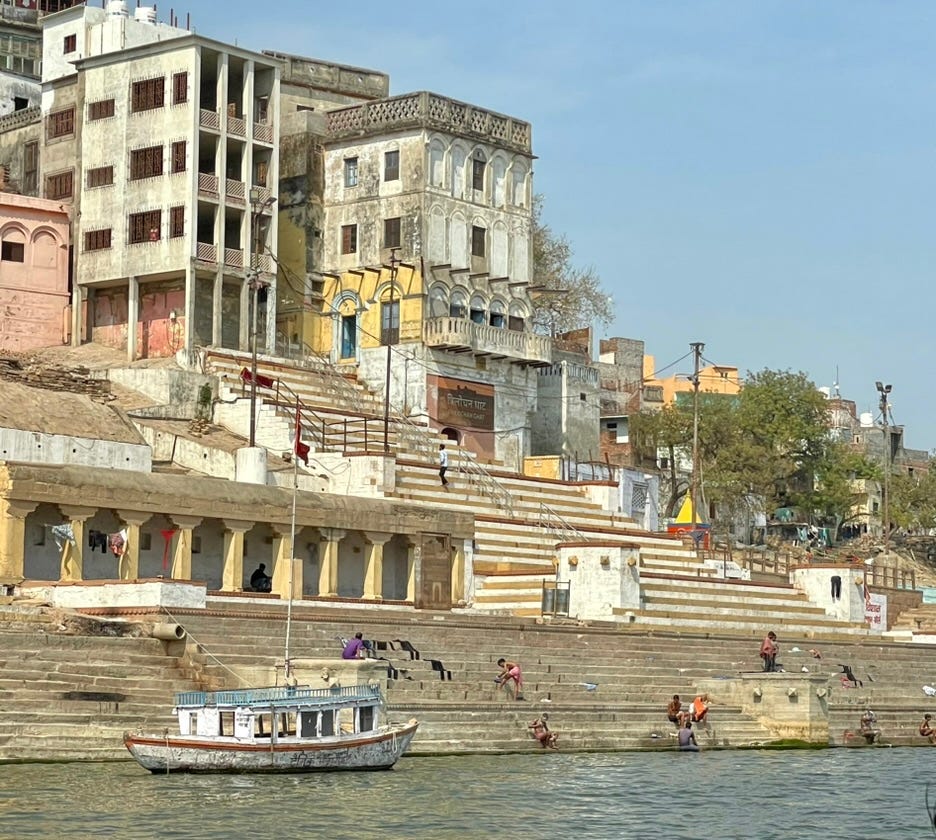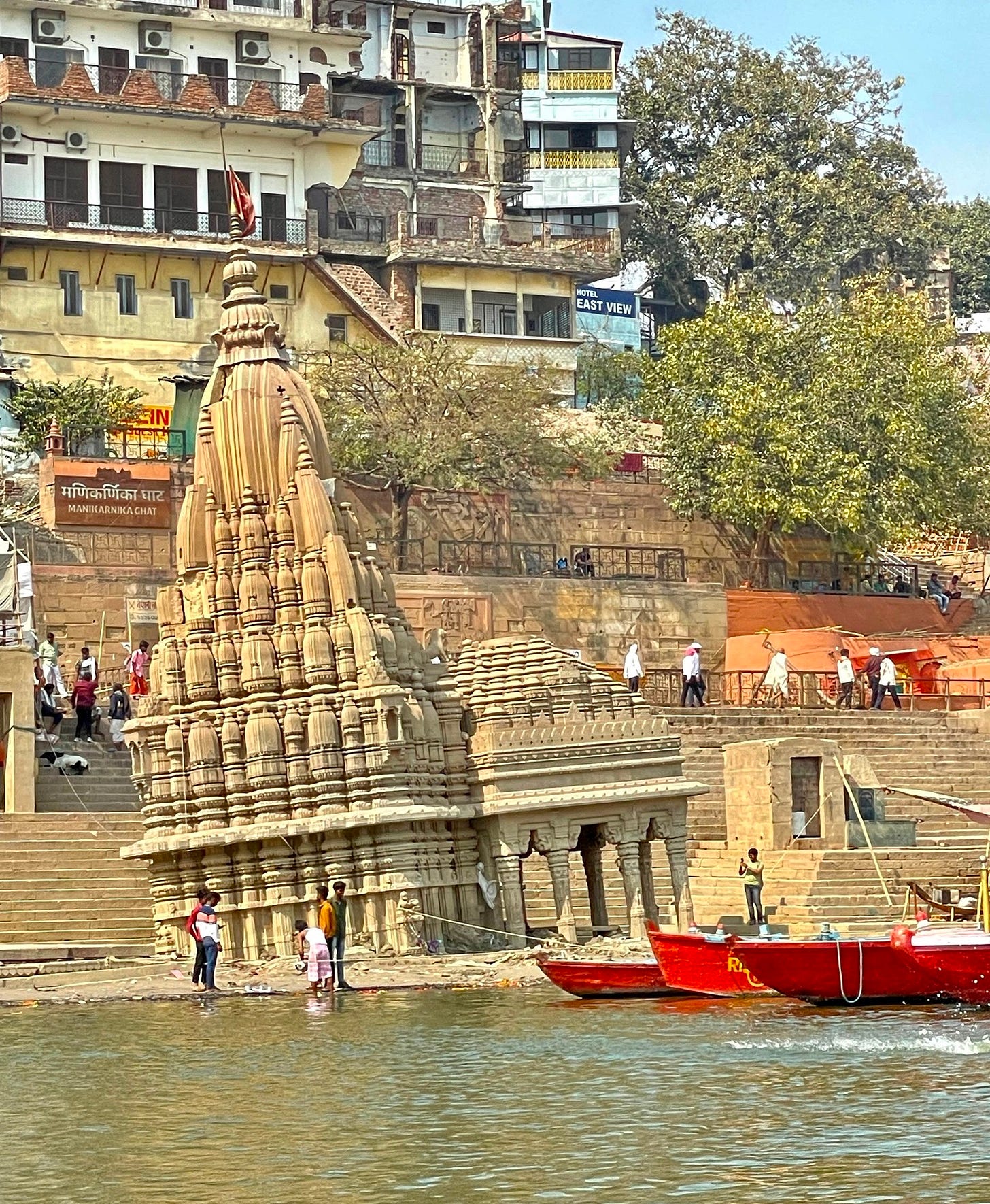I was grateful for the shade as I settled into the hot Indian afternoon, leaning back in my chair and allowing the slight breeze, distant sounds, and smells from the river to wash over me. I am on a rooftop, and although I am the only one here on this sweltering afternoon, I am far from alone.
I am sitting above the banks of the holiest of rivers: the Ganges. Flowing southeast from its glacial beginnings in the Himalayas to the Bay of Bengal, this river winds over a thousand miles; a celestial stream said to have descended to earth, received by Shiva to purify souls. Other traditions, however, offer different versions of this timeless legend, including one in which the river is a goddess taking earthly form to redeem others. These stories, both mystical and haunting, intertwine to form a tradition that holds the river as holy, cosmic, and divine; a purifier.
This belief isn’t just ancient mythology; it’s woven into the living fabric of the city itself. As you move closer to the sacred river, the narrow streets of the ancient city begin to shift, folding you into a spiritual heart where purity, devotion, and ritual respect take precedence. There are many ways this becomes evident, but one of the most visible is that despite welcoming visitors from all over the world, the cafés, hotels, and restaurants along the ghats honor religious tradition by serving only vegetarian fare, and alcohol is strictly prohibited.
From my vantage point, I can see the ghats below, broad stone terraces with long rows of sandstone steps descending to the river. Weathered by centuries of use, some stairways stretch nearly half as wide as a football field, while others are much narrower and steeper. At the bottom, small wooden boats line the shore, operated by locals who offer informal transport along the river between the ghats or across to the far bank.
My travel companions and I arrived by these very steps earlier this afternoon. Though we flew into Varanasi, our journey from the airport was another matter entirely. Drawing closer to the sacred city center, modern streets fade into an ancient network as narrow streets disappear into winding alleyways known as galis. Cars cannot fit, and even motorized rickshaws are denied the space to navigate effectively. With many guesthouses and hotels tucked into the alleys or along the riverfront, access is limited to two options: walk in from a drop-off point, or arrive by boat, as we did.
At the airport, we had arranged with our taxi driver to be dropped at a specific ghat along the river. There, a boat would meet us, taking us the remaining distance to the hotel. Along the western bank, where the city rises, more than eighty ghats exist, each with its own purpose and rhythm: some for bathing or prayer, others for ritual, and a few for cremation. Arriving by boat is not only practical, but also atmospheric; our first true introduction to the city would come from the river itself.
Which is where we found ourselves: standing at the dusty edge of a dirt access road, just above the slow curve of the river. Our driver, kindly attempting to explain in words I couldn’t fully understand, pointed downhill toward the water to what appeared to be a deserted, makeshift floating platform. With a smile and a wave, he drove off, leaving us to shuffle down the slope and across the sand toward the waiting platform, hoping we had understood correctly that this was where the boat would arrive. When, however, we couldn’t say.
It was a fitting introduction to the city: standing at the edge of the Ganges, alone with our uncertainty, in the full heat of the afternoon.
Confusion has a way of stretching time. Wondering and waiting, we stood in the heat, searching the river for any sign that we were in the right place. Time slipped by unnoticed, before we finally saw a wooden boat turning in our direction. As it drew closer, our questions began to soften. Reaching the makeshift dock, a young man stepped off to greet us and offered to help with our bags. We climbed aboard and settled onto wooden benches beneath the canopy, where relief gave way to anticipation for our first glimpse of life along the river, just ahead.
****

That afternoon, the ghats were nearly deserted in the sweltering heat; most people had already sought shelter indoors or along the shaded alleyways. The steps were bare: some yellowed sandstone, worn and sun-bleached; others dark-stained or even painted. Platforms and walls nearby were adorned with vibrant murals, Hindu deities, and scenes of prayer. Along the terraces, a few figures lingered: one sorting through bags of trash, one traversing the steps in ceremonial robes, yet another laying laundry out to dry. At intervals, makeshift stalls appeared, bamboo poles supporting frayed tarps, silver cooking pots stacked beneath rickety tables.
Above the steps, behind another building, I saw the brightly painted, red-tapered shikhara, the beehive-shaped tower that rises above a Hindu temple, named for the mountain peaks it symbolizes. Closer, another one particularly caught my eye: sandstone, unpainted, and leaning sharply, just inches from the water. I later learned it was the Ratneshwar Mahadev Temple, known as the Leaning Temple of Varanasi. Its 9-degree tilt and partially submerged sanctum are striking; its origins unknown.
That unusual sight, however, was merely a prelude. Just beyond lay Manikarnika Ghat, one of the oldest and most sacred cremation grounds in the world. Although I was familiar with its history, viewing it in person was quite another matter. Enormous stacks of wood rose beside the river as smoke drifted upward and flames leapt from the funeral pyres. Seven pyres were visible; one had just been lit, three were actively burning, and another had smoldered to ash that a man was raking. Crowds of people gathered nearby, along the pyres and on the terraces above and below. Cattle and dogs wandered the steps.
It was both disturbing and visceral: death, fully exposed. Reverence, oddly, seemed paired with a sense of celebration. The energy was unmistakable: this is a sacred place, yet not a solemn one.
For Hindus, being cremated on the banks of the Ganges signifies breaking free from the cycle of rebirth and attaining moksha, the highest spiritual goal. The sacred flame at this site has burned continuously for centuries, and cremations occur around the clock. Death is not concealed here; it is folded into the visible, breathing rhythm of the city.
Overall, it was an introduction that was both humbling and stunning. After arriving at the ghat near our hotel, gathering our belongings, and climbing the steps to check in, I found myself in need of a moment of quiet. Fortunately, our lodging provided just such a space.
The rooftop where I sit rises three stories above the ghat, dropping so steeply that it feels almost like the edge of a cliff. From this height, especially at this time of year when the river is low, the stone steps are fully exposed; it’s another thirty steps or more to reach the water’s edge.
Although I enjoy this quiet moment of solitude, it isn’t long before I crave to be out once again; impatient to join the chaotic flow unfolding below me. From up here, it could almost appear orderly, but I already know that as soon as I descend, it will be anything but. However, that is what I’m looking for: the messy, jumbled, seemingly disordered, and overwhelming experience I’ve come to understand as India.
And yet, much to my surprise, I still wasn’t prepared for Varanasi.
****







What a visionary experience with your words!! How fun
So I guess I don’t need to go to India now because you took me there with your brilliant descriptive words. I see a book in your future!